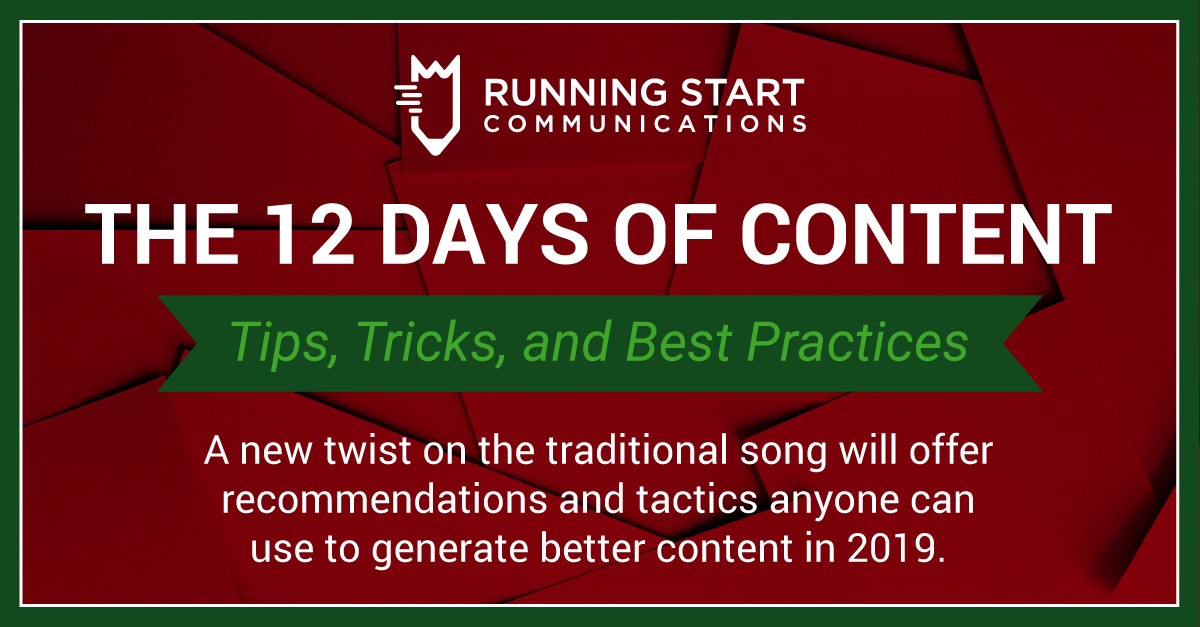
On the fourth day of “Content,” a random writer gave to me …
Four steps anyone can follow to write better content.
I hope this doesn’t seem too basic, but it’s intended to help marketers who aren’t 100% comfortable writing content or anyone who might be new to writing. And hey, who couldn’t use a little refresher from time to time?
Without further ado, here are four steps to writing good content for any type of marketing messages:
1. Hook ’em with a great introduction
This may seem obvious – every piece needs to start somewhere, right? – but it’s so important to get it right and get their attention right away.
Write a great introduction by:
- Leading with a story or a concept your reader may not expect, and makes them want to read more.
- Doing all you can to connect with prospects, either by identifying the biggest challenges they’re facing or describing the benefit they’re trying to achieve. Empathy and altruistic marketing goes a long way.
- Telling them something they don’t know and may surprise them. Third-party research, industry news, and other client successes are all great examples of this.
- Respecting their time. Be as concise as possible. Depending on the piece, you may even consider telling them what they’ll find in the rest of the content. (For example, “This blog offers three additional tips for organizing content for any market message.”)
- Writing it last. Many writers hit their stride at the very end and create better summaries than introductions. Save it until the end!
Do not:
- Lead with product details/features or corporate information. At this point, the prospect doesn’t care about you; he/she only wants to know how your solution or service can help them solve a challenge or achieve a new benefit.
2. Present the solution, but connect it to their business drivers or goals.
Now is the time to start talking about your product or service, but you have to be clear what this means to the customer.
Write a great solution section by:
- Thinking “is-does-means.” It’s not enough to say what your product is or even what it does. Go a step further by explaining what this really means for the customer.
- Tying it to a business benefit. For example, your new cybersecurity tool may offer cool encryption technology, but prospects want to know that it will keep their data safe and/or prevent compliance fines.
Do not:
- Attempt to explain exactly how the product works. Keep it high level and benefit oriented. Prospects won’t buy because of this content piece, so leave some of the details out.
3. Provide proof.
You know that line that goes something like, “But don’t take it from us. Here’s what other’s are saying about their experience with our company. …”? It may be over-used, but it’s an important mindset.
Make sure you’re providing proof that your product will do what you say it will by:
- Giving as much evidence as possible, including actual customer results, cost-savings/ROI data, productivity improvements, analyst quotes and findings, customer testimonials, and more.
- Finding more. Even if product owners tell you they don’t have anything, you can always use customer quotes (from press releases), past awards, third-party research, and more.
- Asking the right questions. Case study participants rarely have the results you need. Be prepared for this and help craft results-oriented content. For example, clients may not have a specific ROI stat, but will go on the record saying they’re twice as productive with your product.
Do not:
- Make data up. We’ve all seen examples where one employee creates a fuzzy stat thinking no one will ever know. But it can make it tough for other employees to explain and could lead to other problems.
4. Summarize and provide a clear, compelling call to action.
Again, an obvious point, but many marketers today forget summaries/conclusions or offer weak CTAs.
You can write great summaries and CTAs by:
- Being concise: One or two sentences should cover it, unless you’re writing a white paper or longer piece.
- Being original: It’s a fine line: Conclusions need to summarize what the piece was all about without using the same language. Invest a little more time and get creative.
- Being specific: Too many pieces end by pointing readers to a website (which may not offer the same information) or asking them to contact their representative (who they may not even know). Offer a much more specific CTA, such as a dedicated landing page, specific URL, or employee contact information.
I hope these random observations are valuable and helping you think about new ways to create better content.
I also hope they’re what you’re looking for. I’m trying to balance bigger, more serious topics with some fun articles (are you ready for the top weasel-y words marketing needs to stop using?), but I’m up for any suggestions you may have.
Feel free to send me an email with any suggestions or feedback you may have.

Leave A Comment